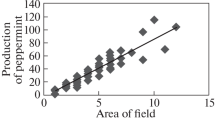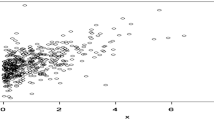Abstract
In the field of data science, the performance of a least square estimator is highly affected if the variable under study departs from normality or has the presence of outliers. This study proposes robust HEWMA-type estimators for the population mean by considering some auxiliary information under a non-normality assumption for a time-based survey. The proposed estimators are found to have the minimum mean square errors and biases compared to other relevant estimators for the long-tailed symmetric family. We have investigated the robustness properties of the proposed estimator in presence of the outliers. Finally, the authors provide a simulation study and a real-life application to support the theoretical outcomes of the proposed estimators over the relevant estimators.




Similar content being viewed by others
Data availability
The corresponding author can provide the data generated and/or analyzed during the current study upon a reasonable request.
References
Ahmed A, Sanaullah A, Hanif M (2019) A robust alternate to the HEWMA control chart under non-normality. Qual Technol Quant Manag 17(4):423–447. https://doi.org/10.1080/16843703.2019.1662218
Cabilio P, Masaro J (1996) A simple test of symmetry about an unknown median. Can J Stat 24:349–361
Chhaparwal P, Kumar S (2022) Improving efficiencies of ratio- and product-type estimators for estimating population mean for time-based survey. J Reliab Stat Stud 15(1):325–340
Chhaparwal P, Kumar S (2023) Robust ratio and product based estimators using known auxiliary information through modified maximum likelihood. Afr Mat 34:83. https://doi.org/10.1007/s13370-023-01127-8
Choudhury S, Singh BK (2012) A class of chain ratio-cum-dual to ratio type estimator with two auxiliary characters under double sampling in sample surveys. Stat Trans -New Ser 13(3):519–536
Cochran WG (1940) The estimation of the yields of cereal experiments by sampling for the ratio of grain to total produce. J Agric Sci 30(2):262–275
Diana G, Giordan M, Perri PF (2011) An improved class of estimators for the population mean. Stat Methods Appl 20:123–140
Gupta S, Shabbir J (2008) On the improvement in estimating the population mean in simple random sampling. J App Stat 35(5):559–566
Gupta S, Shabbir J (2011) On estimating finite population mean in simple and stratified sampling. Commun Statist: Theo Meth 40:199–212
Haq A (2013) A new hybrid exponentially weighted moving average control chart for monitoring process mean. Qual Reliab Eng Int 29(7):1015–1025
Haq A (2017) A new hybrid exponentially weighted moving average control chart for monitoring process mean: discussion. Qual Reliab Eng Int 33(7):1629–1631
Irfan M, Javed M, Lin Z (2019) Enhanced estimation of population mean in the presence of auxiliary information. J King Saud Univ Sci 31(4):1373–1378
Kumar S, Chhaparwal P (2016) A robust dual to ratio estimator for population mean through modified maximum likelihood in simple random sampling. J Appl Probab Stat 11(2):67–82
Kumar S, Chhaparwal P (2017) Robust exponential ratio and product type estimators for population mean using order statistics in simple random sampling. Int J Ecol Econ Stat 38(3):51–70
Kumar S, Chhaparwal P (2019) Ratio- and product-based estimators using known coefficient of variation of the auxiliary variable via modified maximum likelihood. Life Cycle Reliab Saf Eng 8(2):99–116
Kumar S, Chhaparwal P (2021) A simple random sampling modified dual to product estimator for estimating population mean using order statistics. J Mod Appl Stat Methods 19(1):2–32
Kumar S, Chhaparwal P (2023) Utilization of priori information in the estimation of population mean for time-based surveys. Ann Data Sci. https://doi.org/10.1007/s40745-023-00472-6
Kumar K, Kumar S (2020) Two phase sampling exponential type estimators for population mean using auxiliary attribute in the presence of non-response. Int J Math Stat 21(1):75–85
Kumar S, Kumar S, Oral E (2021) Robust ratio- and product-type estimators under non-normality via linear transformation using certain known population parameters. Ann Data Sci 8(4):733–753. https://doi.org/10.1007/s40745-020-00258-0
Kumar S, Chhaparwal P, Kumar K et al (2024) Generalized memory-type estimators for time-based surveys: simulation experience and empirical results with birth weight dataset. Life Cycle Reliab Saf Eng. https://doi.org/10.1007/s41872-023-00239-1
Lloyd EH (1952) Least-squares estimation of location and scale parameters using order statistics. Biometrika 39(1/2):88–95
Miao W, Gel YR, Gastwirth JL (2006) A new test of symmetry about an unknown median. In: Hsiung A, Zhang C-H, Ying Z (eds) Random Z. walk, sequential analysis and related topics: a festschrift in honor of Yuan-Shih Chow. World Scientific Publisher, Singapore, pp 199–214
Mira A (1999) Distribution-free test for symmetry based on Bonferroni’s measure. J Appl Stat 26:959–972
Noor-ul-Amin M (2020) Memory type ratio and product estimators for population mean for time-based surveys. J Stat Comput Simul 90(17):3080–3092. https://doi.org/10.1080/00949655.2020.1795660
Olson DL, Shi Y (2007) Introduction to business data mining. McGraw-Hill/Irwin, New York
Oral E, Kadilar C (2011) Robust ratio-type estimators in simple random sampling. J Kor Statis Soc 40:457–467
Oral E, Oral E (2011) A robust alternative to the ratio estimator under non-normality. Statist Prob Lett 81:930–936
Puthenpura S, Sinha NK (1986) Modified maximum likelihood method for the robust estimation of system parameters from very noisy data. Automatica 22:231–235
Rao JNK, Beegle LD (1967) A Monte Carlo study of some ratio estimators. Sankhya Ser B 29:47–56
Shi Y (2022) Advances in big data analytics: theory, algorithm and practice. Springer, Singapore
Shi Y, Tian YJ, Kou G, Peng Y, Li JP (2011) Optimization based data mining: theory and applications. Springer, Berlin
Singh HP, Solanki RS (2012) An alternative procedure for estimating the population mean in simple random sampling. Pak J Stat Oper Res 8(2):213–232
Tien JM (2017) Internet of things, real-time decision making, and artificial intelligence. Ann Data Sci 4(2):149–178
Tiku ML, Akkaya AD (2004) Robust estimation and hypothesis testing. New Age International (P) Limited, New Delhi
Tiku ML, Bhasln P (1982) Usefulness of robust estimators in sample survey. Commun Statist: Theo Meth 11:2597–2610
Tiku ML, Kumra S (1981) Expected values and variances and covariances of order statistics for a family of symmetric distributions (student’s t). Selected tables in mathematical statistics, vol 8. Amer Math Soc, pp 141–270
Tiku ML, Suresh RP (1992) A new method of estimation for location and scale parameters. J Stat Plann Infer 30:281–292
Tiku ML, Vellaisamy P (1996) Improving efficiency of survey sample procedures through order statistics. J Ind Soc Agric Stat 49:363–385
Tsay RS (2010) Analysis of financial time series. Wiley, New Jersey
Vaughan DC (1992) Expected values, variances and covariances of order statistics for student’s t-distribution with two degrees of freedom. Commun Statist-Simul Comput 21:391–404
Vaughan DC, Tiku ML (2000) Estimation and hypothesis testing for non normal bivariate distribution with applications. Math Comp Model 32:53–67
Acknowledgements
The authors are heartily thankful to the editors and the referees for their constructive comments on bringing the original manuscript to its present form.
Author information
Authors and Affiliations
Corresponding author
Ethics declarations
Conflict of interest
There is no conflict of interest.
Additional information
Publisher's Note
Springer Nature remains neutral with regard to jurisdictional claims in published maps and institutional affiliations.
Rights and permissions
Springer Nature or its licensor (e.g. a society or other partner) holds exclusive rights to this article under a publishing agreement with the author(s) or other rightsholder(s); author self-archiving of the accepted manuscript version of this article is solely governed by the terms of such publishing agreement and applicable law.
About this article
Cite this article
Jakhar, A., Kumar, S. Robust HEWMA-type estimators for population mean under non-normality. Life Cycle Reliab Saf Eng 13, 33–49 (2024). https://doi.org/10.1007/s41872-024-00244-y
Received:
Accepted:
Published:
Issue Date:
DOI: https://doi.org/10.1007/s41872-024-00244-y




